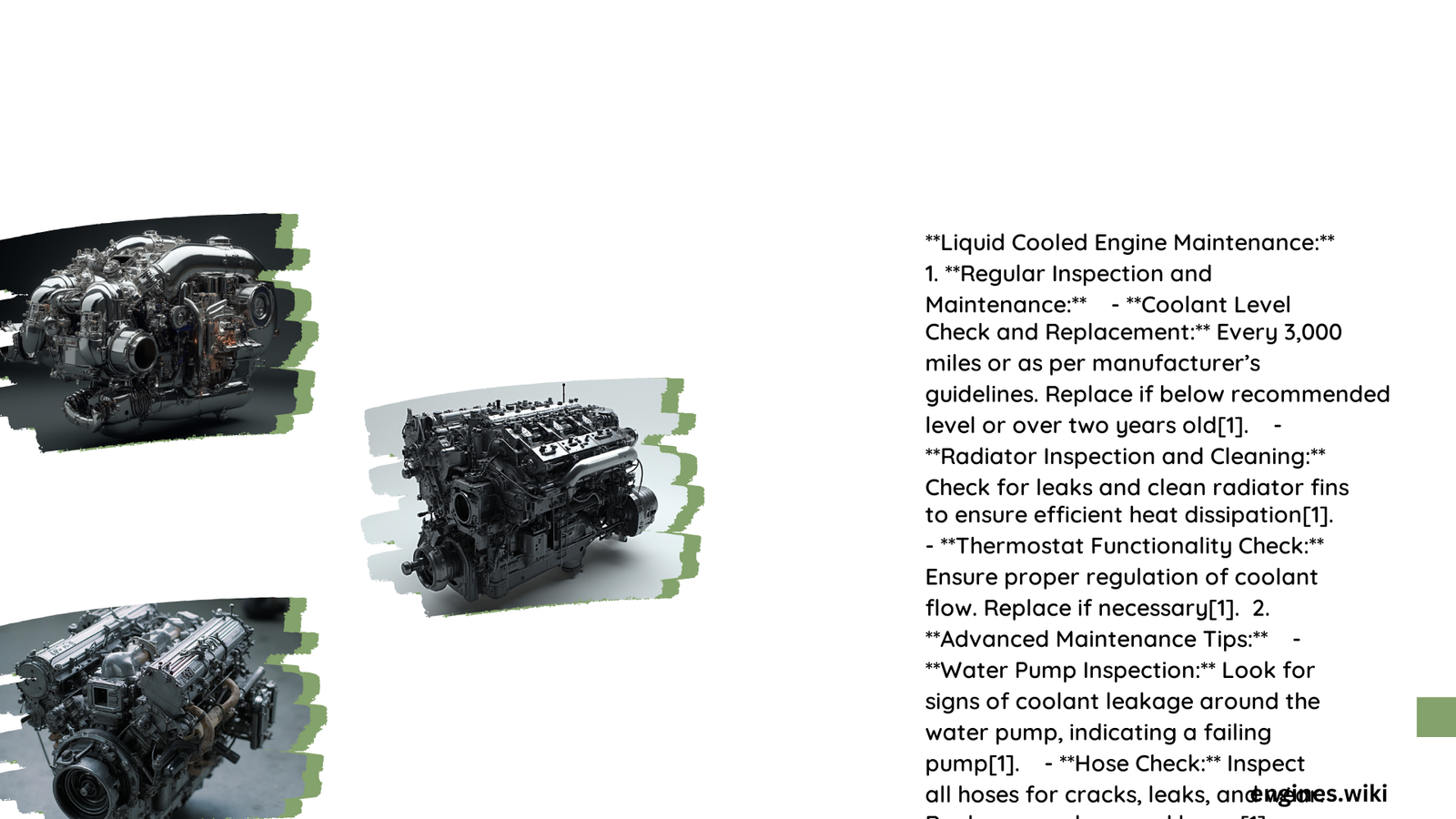Liquid cooled engine maintenance is crucial for optimal vehicle performance and longevity. This comprehensive guide covers coolant replacement, radiator cleaning, thermostat inspection, and leak detection. By following these maintenance procedures, vehicle owners can ensure their liquid cooled engines operate efficiently and avoid costly repairs.
What Are the Key Components of Liquid Cooled Engine Maintenance?
Liquid cooled engine maintenance involves several critical components:
- Coolant management
- Radiator care
- Thermostat functionality
- Leak prevention and detection
Each of these elements plays a vital role in maintaining the health of your vehicle’s cooling system.
How Often Should Coolant Be Replaced?

Coolant replacement intervals vary depending on the vehicle manufacturer, model, and type of coolant used. Here’s a general overview:
| Manufacturer | Replacement Interval |
|---|---|
| Hyundai | First 60,000 miles, then every 30,000 miles |
| Mercedes-Benz | 30,000 to 150,000 miles or 12 to 15 years |
| Chevrolet | Typically every 150,000 miles |
| Toyota | First at 100,000 miles or 5 years, then every 50,000 miles or 5 years |
For older vehicles, a general recommendation is every 2-3 years or around 60,000 miles. Modern vehicles with long-life coolants may extend this interval to 5 years or 100,000 miles, with some lasting up to 10 years or 300,000 miles.
What Is the Proper Procedure for Radiator Cleaning?
Radiator cleaning is an essential part of liquid cooled engine maintenance. Follow these steps for a thorough cleaning:
- Gather necessary tools:
- Radiator draincock or drain valve
- Hose for coolant drainage
- New coolant (appropriate type and quantity)
- Funnel
- Cleaning agents (if needed)
-
Protective gear (gloves and safety glasses)
-
Locate the radiator draincock, typically at the bottom of the radiator or connected to a hose.
-
Drain the old coolant:
- Open the draincock and allow complete drainage
- Direct flow away from the vehicle
-
Close the draincock after draining
-
Flush the cooling system:
- Use a radiator flush kit for heavily contaminated systems
- Circulate flushing agent as per manufacturer instructions
-
Drain the flushing agent
-
Refill the system:
- Use a 50/50 mixture of antifreeze and water or pre-diluted coolant
- Fill slowly through the radiator cap to avoid air pockets
-
Consult the owner’s manual for specific filling procedures
-
Bleed the system:
- Start the engine to circulate new coolant
- Check for leaks and ensure proper bleeding
Always prioritize safety by wearing protective gear and properly disposing of old coolant.
How to Inspect and Test a Thermostat?
Thermostat inspection is crucial for maintaining proper engine temperature. Here’s how to inspect and test a thermostat:
- Check for failure signs:
- Overheating
- Inconsistent engine temperature
-
Coolant leaks around the thermostat area
-
Test the thermostat:
- Remove the thermostat
- Submerge in boiling water
- Check if it opens at the correct temperature (usually 180-195°F or 82-90°C)
-
For electrical thermostats, use a multimeter to check electrical function
-
Replacement considerations:
- Replace if the thermostat fails the above tests
- Consider replacement during coolant changes
What Are Effective Methods for Cooling System Leak Detection?
Detecting and addressing cooling system leaks is vital for liquid cooled engine maintenance. Here are effective methods:
- Visual inspection:
- Check hoses, connections, and components for signs of leakage or damage
-
Use a flashlight for thorough examination
-
Pressure testing:
- Utilize a cooling system pressure test kit
-
Pressurize the system to identify leaks
-
UV dye testing:
- Add UV dye to the coolant
- Use a UV light to locate leaks
Common leak types include:
– Hose leaks (cracks, soft spots)
– Radiator leaks (seams, tubes)
– Water pump leaks (seals, gaskets)
Average repair costs:
– Hose replacement: $50-$200
– Radiator replacement: $300-$1,000+
– Water pump replacement: $300-$1,000+
By following these liquid cooled engine maintenance procedures, vehicle owners can ensure optimal performance and longevity of their engines. Regular inspections, timely coolant replacements, and prompt leak repairs are key to maintaining a healthy cooling system.
